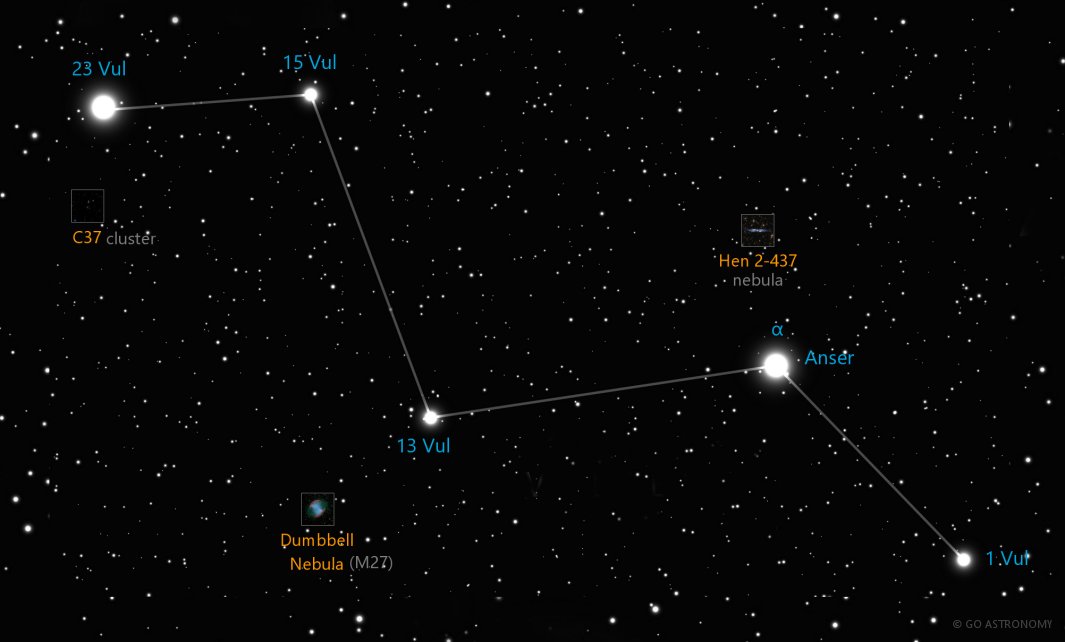Vulpecula, the Fox (Vul)
(vul-PECK-yuh-luh)
The Northern constellation of Vulpecula, the Fox, is best viewed in Fall during the month of September.
Vulpecula is the 55th largest constellation. It's brightest star is Anser at magnitude 4.44. The boundary of the Vulpecula constellation contains 5 stars that host known exoplanets.
- Pronunciation:
- vul-PECK-yuh-luh
- Meaning:
- Fox
- Genitive:
- Vulpeculae
- Abbreviation:
- Vul
- Asterism:
- Coathanger
- Constellation Family:
- Hercules
- Hemisphere:
- Northern
- Quadrant:
- NQ4
- Visibility:
- 90° N - 55° S
- Best viewing month*:
- September
- Area:
- 268 sq. degrees
- Size:
- 55th largest
- Right Ascension (avg):
- 20h 22m
- Declination (avg):
- 24°
- Brightest star:
- Anser (4.44)
- Stars with planets:
- 5
- X-ray stars:
- 2 (binary) stars
Brightest Stars in Vulpecula
The 10 brightest stars in the constellation Vulpecula by magnitude.
- Star
- Magnitude
- Spectral class
- Alpha Vulpeculae (α Vul)
- 4.44
- M0III comp
- 23 Vulpeculae (23 Vul)
- 4.5
- K3III
- 31 Vulpeculae (31 Vul)
- 4.56
- G8III
- 13 Vulpeculae (13 Vul)
- 4.57
- B9.5III
- 15 Vulpeculae (15 Vul)
- 4.66
- A4III
- 1 Vulpeculae (1 Vul)
- 4.76
- B4IV
- HR 7739
- 4.79
- B3V
- 29 Vulpeculae (29 Vul)
- 4.81
- A0V
- 12 Vulpeculae (12 Vul)
- 4.9
- B2.5V
- 30 Vulpeculae (30 Vul)
- 4.92
- K2III
Nebulae in Vulpecula
Notable and easy-to-find nebulae in the constellation Vulpecula . Also see all nebulae.
Galaxies in Vulpecula
The most notable galaxies in the constellation Vulpecula. Also see all galaxies.
Neutron Stars in Vulpecula
These are the most well-known neutron stars in the constellation Vulpecula. Although neutron stars cannot be seen in any amateur telescope, they are at the center of many supernova remnant nebulae, which can be seen. Also see all neutron stars.
Black Holes in Vulpecula
These are the most well-known smaller (non-supermassive) black holes in the constellation Vulpecula. Although black holes cannot be seen directly, the smaller ones are at the center of some star clusters and supernova remnant nebulae, which can be seen. Supermassive black holes are at the center of most galaxies, such as Sagittarius A* at the center of our Milky Way galaxy. Also see all black holes.
- Black hole
- Type
- QZ Vul
- stellar
The Cosmic Fox
Small but significant, the constellation Vulpecula weaves its own unique pattern across the night sky. It may not be as familiar as Orion or Ursa Major, but Vulpecula, or the "Little Fox," holds its own charm and significance. This article will delve into Vulpecula's historical context, main features, significant stars, and deep-sky objects, as well as tips for observing this constellation.
Historical Overview
Vulpecula was introduced in the 17th century by the Polish astronomer Johannes Hevelius. Originally named "Vulpecula et Anser," meaning "the little fox with the goose," it represented a fox carrying a goose in its jaws. However, over time, the goose aspect was dropped, and today, it's simply known as Vulpecula - the Little Fox.
Location and Main Characteristics
This small constellation spans approximately 268 square degrees and is nestled in the fourth quadrant of the northern hemisphere (NQ4). It lies sandwiched between Cygnus, Hercules, Lyra, Pegasus, and Sagitta, making it part of the "Sea of Stars," an area of the sky filled with constellations named after birds.
Significant Stars in Vulpecula
Despite its relative obscurity, Vulpecula hosts a variety of interesting stars. Its brightest star, Alpha Vulpeculae, also known as Anser, is a spectral class M1III red giant that is approximately 297 light-years from Earth. Despite its classification as "Alpha," it's not as bright as some of the other stars in the constellation due to its cooler temperature and lower luminosity.
Another significant star is the 23 Vulpeculae or HD 188228. It's a binary system approximately 891 light-years away, comprising two blue-white B-type main sequence dwarfs. The system is known for its peculiar spectra and variable radial velocity.
Deep-Sky Objects in Vulpecula
Despite its small size and relatively dim stars, Vulpecula is home to some impressive deep-sky objects. Most notably, it hosts the Dumbbell Nebula (M27), which was the first planetary nebula ever discovered. Named for its distinctive shape that resembles a dumbbell or an apple core, the nebula is a favorite target for amateur astronomers and can be observed with a small telescope.
Another notable deep-sky object in Vulpecula is the Brocchi's Cluster (Collinder 399), commonly referred to as the Coathanger. Despite being labeled as a cluster, recent studies suggest that it's more likely an asterism, a chance line-of-sight alignment of stars.
Observation
Vulpecula is best viewed during the months of July to October. As it's located in the northern hemisphere, it's more easily seen from the northern latitudes. However, its southern parts are visible from southern latitudes as well.
To locate Vulpecula, one should first find the Summer Triangle, a large asterism formed by three bright stars: Deneb in Cygnus, Vega in Lyra, and Altair in Aquila. Vulpecula is found within this triangle, though identifying it may require a starmap due to the constellation's relatively dim stars.
Despite its modest size and brightness, Vulpecula is a delightful destination for stargazers with its historical significance and fascinating celestial objects. So, as you scour the night skies, don't forget to pay a visit to the 'Little Fox' hiding amidst the Sea of Stars.
* Constellation shown for northen hemisphere skies. For the southern hemisphere, constellations appear rotated 180 degrees (upside-down and left-right reversed) from what is shown. Remember that seasons are reversed too - summer in northern latitudes is winter in southern latitudes.
** Circumpolar constellations are visible year-round in the hemisphere listed (and not at all in the opposite hemisphere).





